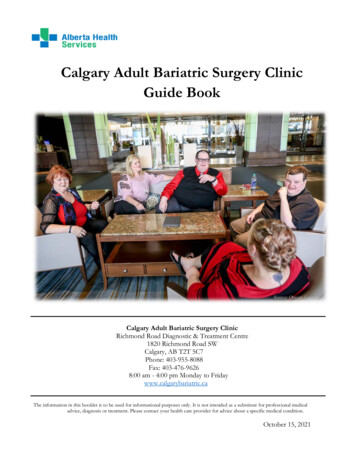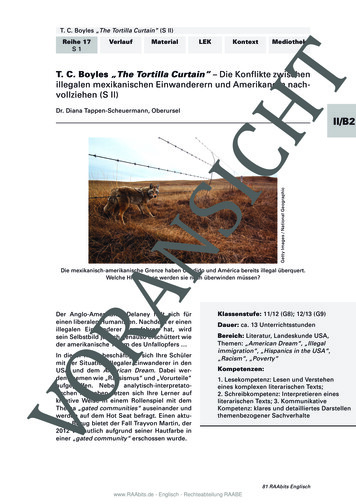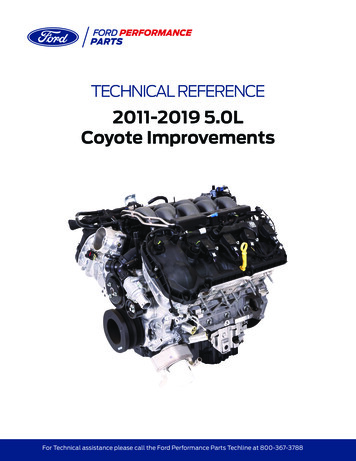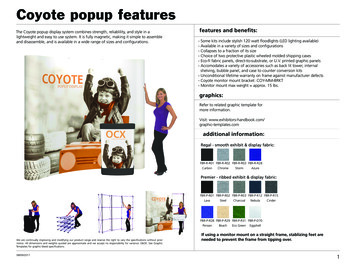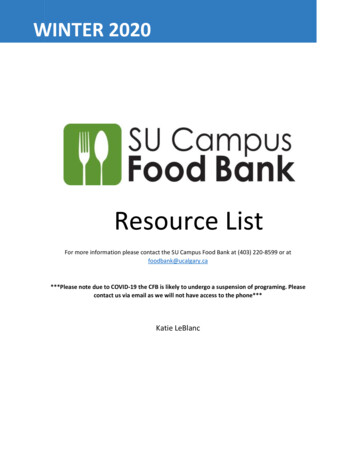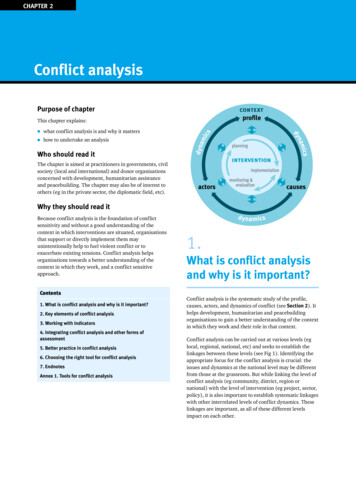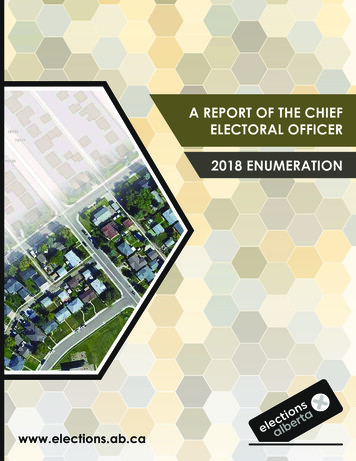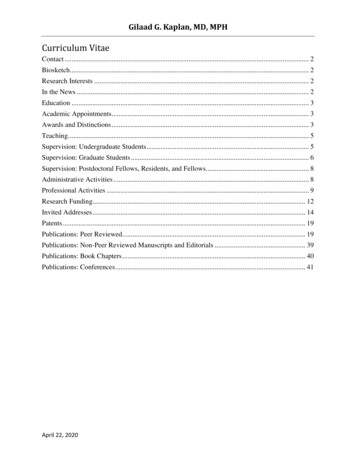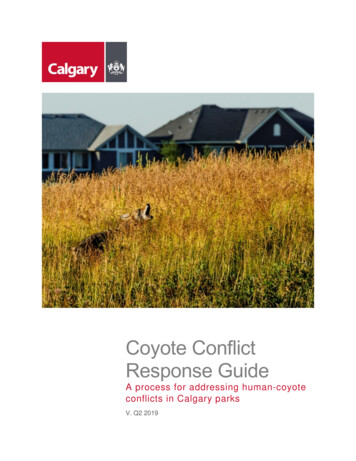
Transcription
Coyote ConflictResponse GuideA process for addressing human-coyoteconflicts in Calgary parksV. Q2 2019
Publication informationTitle:Coyote Conflict Response Guide: a process for addressing human-coyoteconflicts in Calgary parks.Intent:This document guides City of Calgary Parks staff and/or its contractors inmanaging human-coyote conflict on land that is stewarded by CalgaryParks. This guide establishes a consistent and appropriate nonemergency response to human-coyote conflict reports received by TheCity and occurring in Calgary parks.Prepared by:The City of Calgary, Calgary Parks, Urban Conservation, ConservationPolicyVersion:Q2 2019Information:Corporate Call Centre: 3-1-1 (within Calgary)---CopyrightCopyright The City of Calgary 2018. No part of this work may be reproduced by any meanswithout written permission from The City of Calgary.Terms of useThis guide is presented as accurate and complete as of the date indicated above. Use of thisdocument does not absolve any user from the obligation to exercise their professional judgmentand to follow good practice under Canada’s legislative framework. Should any user havequestions regarding the content of this report, the user is advised to seek clarification from thelead of Urban Conservation, Calgary Parks.Revision noticeDate of reviewDescriptionCover photograph by City of Calgary staff.Coyote Conflict Response Guide2ISC: Unrestricted
Table of ContentsPublication information . 2Copyright . 2Terms of use . 2Revision notice. 2Purpose . 4Legislative authority . 4Strategic plan and policy context . 4Introduction . 5Principles for Active Co-existence with Coyotes . 6Coyote conflict response process. 61.COYOTE REPORT CLASSIFICATION . 7A)Preliminary report classification . 9B)Investigation .11C)Final classification .122.RESPONSE .123.ROLES AND RESPONSIBILITIES .21Glossary.22References .24Appendices .26APPENDIX A – COYOTE PHONE INVESTIGATION FORM .26APPENDIX B – FIELD INVESTIGATION PROCESS .28APPENDIX C – BYLAW INFRACTIONS .29APPENDIX D – FORTHCOMING APPENDICES TO THIS DOCUMENT .33Coyote Conflict Response Guide3ISC: Unrestricted
PurposeThis guide provides Calgary Park staff and/or its wildlife management contractors with aneffective and informed response process for non-emergency human-coyote conflict reportsreceived through The City of Calgary’s 311 system or by other means. This document instructsCity Parks staff how to classify the coyote activity described in a report, and outlines the level ofresponse required to address the coyote activity.In the event of an emergency report regarding coyotes where there is an immediate threat topublic safety that requires an immediate response, the report is received and handled by 911dispatch. An emergency response is outside the scope of this guide.Currently this guide applies to City land managed by Calgary Parks. The intent is to evaluate theefficacy of this guide (Appendix D) and, if it is successful, expand its scope to all City-ownedland. Thus this guide is a living document and its processes and appendices may be updated asappropriate.Legislative authorityNatural resources, including wildlife, fall under the Provincial sphere of jurisdiction. Themanagement of coyotes is regulated by Alberta’s Agricultural Pests Act, RSA 2000 c A-8 andassociated Pest and Nuisance Control Regulation. Within this legislation, coyotes are declareda nuisance. Under the Act, an owner or occupant of land may “prevent the establishment of,control or destroy a nuisance on land the owner owns, or occupier occupies” (Province ofAlberta 2000). Thus The City of Calgary’s role in coyote management is as a landowner on Cityowned land; it does not have authority to manage coyotes on private land.Though declared a nuisance under Alberta’s Agricultural Pests Act, coyotes are consideredwildlife under Alberta’s Wildlife Act, RSA 2000 c W-10 (Province of Alberta 2000); they are animportant part of Calgary’s ecosystems and the biodiversity of Calgary park land. Thisdesignation affects how coyote dens may be managed, which has implications for potentialresponses to human-coyote conflicts and the processes provided within this guide.Strategic plan and policy contextThis guide is aligned with Calgary’s Our BiodiverCity strategic plan (The City of Calgary Parks2015) and associated Biodiversity Policy (CSPS037), approved by City Council in March 2015(The City of Calgary 2015). The strategic plan’s principles of integration and ecological literacydrive the approach taken in this guide.Integration – The City of Calgary works with communities and businesses to buildneighbourhoods that support local biodiversity conservation, healthy ecologicalprocesses and provide equitable access to nature.Ecological literacy – The City of Calgary supports the conservation and appreciation ofbiodiversity by cultivating knowledge and understanding about ecological processes,personal stewardship actions and Calgary’s natural heritage.Coyote Conflict Response Guide4ISC: Unrestricted
Further, the Biodiversity Policy includes the following commitment and procedure that providesthe mandate to develop this guide:Commitment – Plan and manage Calgary parks and open space as a connectednetwork of habitats and wildlife movement corridors, with the aim of reducing roadwaycollision threats and related human-urban wildlife conflict.Procedure – Integrate with wildlife, plants and natural heritage: Conserve lands andwaters that are critical in retaining essential local ecosystem function, structure, qualityand resilience, while ensuring appropriate access and use.IntroductionCoyotes (Canis latrans) are a natural part of Calgary’s ecosystem and their ability to adapt hashelped them thrive in urban environments (Alexander and Quinn 2011; Poessel et al. 2013).They play an important role in the healthy function of urban ecosystems by helping to regulatepopulations of various species including white tailed deer (Odocoileus virginianus), Canadageese (Branta canadensis), rabbits and rodents.In general, coyotes can live in close proximity to humans with little conflict (Gehrt et al. 2009,Poessel et al. 2013). However, in many municipalities across North America, human-coyoteconflict has become an emerging issue. As a result, various municipalities have created acoyote management plan (Baker and Timm 1998, Timm and Baker 2007, Alexander and Quinn2011, Poessel et al. 2013).An effective coyote response plan must consider both public safety and the benefits of having ahealthy predator population to aid ecosystem balance (Alberta Government 2016). A commonelement throughout the scientific literature and municipalities’ management plans is that toreduce human-coyote conflict, education and proactive management is required (Baker 2007,Worcester and Boelens 2007, Alexander and Quinn 2011, Lukasik and Alexander 2011,Poessel et al. 2013).This response guide is based on scientific literature and best management practicesrecommended by wildlife researchers and employed by other urban jurisdictions across NorthAmerica (City of Calabasas (n.d), City & County of Denver 2009, City of Torrance (n.d.), TheHumane Society of the United States (n.d.), and Town of Superior 2014). It includes a variety ofmanagement tools including communication, citizen and coyote behaviour modification andresponse(s) to human-coyote conflict.Coyote Conflict Response Guide5ISC: Unrestricted
Principles for Active Co-existence with CoyotesAs per the Biodiversity Policy (The City of Calgary 2015), The City’s goal is for citizens andcoyotes to co-exist whenever possible. The City’s principles for co-existence are: Human safety and their pets is a priority;Wildlife and their habitat is important to the citizens of Calgary and to Calgary’sbiodiversity and urban ecosystems;Coyotes serve an important role in Calgary’s ecosystem by helping to controlpopulations of deer, rodents and other prey;Calgarians have a key role to play in minimizing human-coyote conflict;Minimizing human-coyote conflict must address problematic behaviours of both thecoyote (e.g., aggression towards people and pets) and humans (e.g., intentionally orunintentionally feeding coyotes, not removing pet feces from parks or yards, impropergarbage disposal, etc.) that contribute to conflict;Public education and communication are essential to co-existence with coyotes;Coyote conflict management practices are based on an understanding of their biologyand urban ecology;Non-selective coyote removals are not effective for reducing coyote populations orpreventing human-coyote conflicts;The City seeks an emphasis on non-lethal coyote management techniques; andLethal removal of a coyote is an option if it is deemed necessary; it should be selectiveand aimed at specific individuals whose undesirable behaviour cannot be changed byother methods.Coyote conflict response processThis document is intended to provide a step-by-step process to assist City staff and approvedwildlife management contractors to respond to human-coyote conflict on land stewarded byCalgary Parks. The process starts with a human-coyote interaction that is reported by acitizen(s) to The City of Calgary (The City), and The City classifying the report based on aninvestigation. The investigation informs a response based on the report’s classification. Finallythe response is evaluated using adaptive management techniques to ensure success (Figure1).Coyote Conflict Response Guide6ISC: Unrestricted
Figure 1. Overall coyote response process, including citizens’ and The City of Calgary’sroles. Human-coyote interactions may include any observations of coyote activity orhuman-coyote conflicts. Evaluation methods are forthcoming (see Appendix D).This guide is not intended to provide prescriptive responses; it guides an outcomes-basedprocess intended to provide direction and rationale for The City’s response. The guide providesdirection on the following:1. Coyote report classification process2. Response decision process3. Roles and responsibilitiesThese three actions are described below.1. COYOTE REPORT CLASSIFICATIONThis section describes the classification process for coyote reports received by The City. Coyotereports are classified as either Observation, Conflict, or Sick/injured (Table 1). An Observation isfurther classified as a Sign, Sighting, or Encounter; a Conflict is further classified as an Incident,Pet-Attack, or Human-Attack (Table 2). This classification system forms the framework fordetermining whether human-coyote interactions require further investigation or response.Table 1. Broad classification of a coyote njuredDefinitionA broad coyote report classification where there was no interaction, or where acoyote’s presence did not result in a conflict between a human and/or pet and acoyote, and includes the finer classifications of sign, sighting, and encounter.A broad coyote report classification that describes an interaction between ahuman and/or pet and a coyote that caused harm or where there was apotential/perception of harm, and includes the finer classifications of incident, petattack, and human-attack.Coyote appears lethargic, indifferent or aggressive. Shows signs of scaropticmange (hair loss). Injured coyotes are often seen limping.Coyote Conflict Response Guide7ISC: Unrestricted
Table 2. Classification of a coyote report (adapted from Poessel et al. Human-AttackSick/InjuredDefinitionThe act of noticing or taking note of tracks, scat or vocalizationsthat indicate activity of coyote(s) in an area.A visual observation of a coyote(s).An interaction between a human and a coyote that is withoutincident.A conflict between a human and a coyote where a coyoteexhibited behaviour creating an uncomfortable situation for thehuman; includes baring teeth, growling, snarling, stalking ahuman or crouching as if to attack a human.Domestic pet is attacked by a coyote (either injured or killed).A conflict that involves physical contact between a coyote and ahuman; a human is injured or killed by a coyote.N/AThe classification process involves three major steps (Figure 2):A) Preliminary report classification;B) Investigation; andC) Final classification.Preliminary report classification is based on the description of the event as reported by thecitizen. The investigation process confirms or modifies the preliminary classification, whichresults in a final classification for the report. This final classification determines The City’sresponse. For some response types, a finer classification (i.e., Incident vs. Pet-Attack vs.Human-Attack for Conflicts) is used to determine the response (see Section 2. Response).The following sections align with the alphanumerical steps illustrated in Figure 2, with each stepfurther described below. At certain steps, the report response coordinator (see Section 3 Rolesand responsibilities) is required to choose between two different options. These steps areindicated with a symbol. After each choice the words go to section are written. The reportresponse coordinator then skips ahead to that section, ignoring the sections in between. If thereis no prompt to go to another section, the report response coordinator continues to the nextsection in the guide.Coyote Conflict Response Guide8ISC: Unrestricted
Figure 2: Flow chart for classifying Coyote Reports. *Sick is an abbreviation forsick/injured.A)Preliminary report classificationThe preliminary report classification process involves both the perspective of the citizendescribing and submitting a coyote report to The City, and a classification of the report byCalgary Parks staff based on a standardized classification system (Table 1). This provides thebasis for further investigation of the coyote report, as necessary.A1) City notifiedCitizens can report coyote activity to The City via: 311, 911, Calgary Police Service nonemergency line, personal accounts, media and social media. These reports also include avariety of useful information including, but not limited to, the date, time and location of theCoyote Conflict Response Guide9ISC: Unrestricted
incident. It also includes a description of the event as reported by the citizen submitting thereport.A2) Preliminary coyote report classificationCalgary Parks staff review a coyote report after it is received. Reports should be checked daily ifpossible, and must be checked within five business days. Training is required for City staff tocheck the reports in the 311 system to review coyote reports. Training can be received from theCalgary Parks Web/311 Coordinator.During the report review, preliminary classification begins (see Figure 2, step A2). Reports maybe classified as either Observations or Conflicts based on the report’s description, following theclassification definitions in Table 1 and Table 2. In this step of the process the report is onlyclassified into the broad classification of Observation or Conflict (Table 1).Reports from 311 have an initial categorization, while reports from other sources may not haveany initial categorization and the information provided can vary. The following sections describehow to make a preliminary classification for both types of reports.Reports from 311Reports received by a Customer Service Representative (CSR) through 311 are initiallyassigned to one of seven classifications (normal, aggressive, sick/injured, den/nest, scavenginggarbage, protecting young, and other) built into the existing 311 system. These seven types areonly used in the existing 311 reporting system and are consistent across most wildlife reports;they simplify the process for 311 CSRs who are not experts on coyote behaviour and reduce thepotential for misclassification of the report in the initial stages.During classification, 311 report comments must also be made. If the behaviour reported in thecomments do not match the initial categorization given by the CSR, the report may be classifiedbased on the comments. If there is insufficient information to make a clear decision on thepreliminary classification, the default preliminary classification is conflict; all conflicts areinvestigated and the report classification will be confirmed during that process. Coyotes that are categorized in 311 reports as normal, den/nest, scavenging garbage orother, are then assigned a preliminary classification as an Observation, go to section A3. Coyotes that are categorized in 311 as aggressive or protecting young are thenassigned a preliminary classification as a Conflict, go to section B1. Coyotes that are categorized in 311 as Sick/injured, a phone investigation should beconducted to confirm if sick or injured, go to section B1.Reports received outside of 311Reports that are received from outside of the 311 system should be classified based on thebehaviour described within the report. If there is insufficient information to make a clear decisionon the preliminary classification, the default preliminary classification is a conflict. If the report is classified as an Observation, go to section A3. If the report is classified as a Conflict, go to section B1. If the report is classified as Sick/injured, a phone investigation should be conducted toconfirm, go to section B1.Coyote Conflict Response Guide10ISC: Unrestricted
A3) Did the citizen express concern?An observation report is not investigated unless a citizen expresses a concern in the report.Concerns could include, but not be limited to, coyotes seen in areas of concern like yards andschool fields, coyotes being sighted in an area regularly, etc.). If the report is classified as an Observation and the citizen expresses concern, a phoneinvestigation should occur to confirm the report, go to section B1. This will ensure thatConflicts (which are more serious) are not misclassified as Observations.B)InvestigationThe investigative process verifies reports, strengthens accurate classification and provides thespecifics necessary to formulate the appropriate site-specific response; it includes a phoneand/or field investigation (Figure 2). There are also opportunities to educate citizens whileconducting the investigation by directing them to the Calgary.ca website, on which a search forcoyotes turns up more information.All reports are mapped by Calgary Parks staff to assess activity across the City. If an area isdeemed as an area of high coyote activity due to the number of reports over a period of time,then a field investigation may be triggered, even if a Conflict has not occurred.B1) Did the citizen provide contact information? If the report is classified as either a Conflict or Observation with citizen concern, and acitizen left their phone number, go to section B2. If a citizen did not leave their phone number, go to section B4.B2) Complete the “Phone Investigation Form”The City will contact the citizen via phone. During the phone call, a printed version of theinvestigation form (Appendix A) is completed. Once completed, go to section B3.B3) Classification based on phone investigationThe response coordinator will look at the information provided in the phone investigation andconfirm the classification based on the definitions in Table 1. If the coyote report is classified as a Conflict, go to section B5. If the coyote report is reclassified as an Observation, go to section C1.B4) Is a specific location provided?If a report is classified as: i) a Conflict or; ii) as an Observation with a concerned citizen, and thecitizen did not leave a name or number, a phone investigation is not possible. If phone investigation is not possible, go to section C2. If a specific location is provided (an address or specific directions so a location can befound in a park) a field investigation occurs, go to section B5.Coyote Conflict Response Guide11ISC: Unrestricted
B5) Complete Field Investigation FormField investigations will follow the field investigation process (Appendix B). Investigations areconducted by Calgary Parks staff or The City’s wildlife management contractor. Complete the field investigation and go to section B6.B6) Classification based on field investigationThe City will look at the information provided in the field investigation and confirm theclassification of Observation or Conflict based on Table 1. If the report is a Conflict, go to section C2. If the report is reclassified as an Observation, go to section C1.C)Final classificationFor the final classification, reports are further classified (Table 2) based on the informationobtained through the classification process. These sub-classifications help to hone theresponse.C1) ObservationBased on the information provided during the investigation process, observation reports areclassified as Sign, Sighting, or Encounter (Table 1). For reports that are classified as Observations, go to section C3.C2) ConflictBased on the information provided during the investigation process, conflict reports areclassified as Incident, Pet-attack or Human-attack (Table 1). Once this has been completed, go to section C3.C3) ResponseFor responses see the response section (Section 2). This process will determine the responsetype based on the specific situation and location.2. RESPONSEThe possible responses to a coyote report based on its classification are outlined in Table 3.How to apply the response according to the classification is described in Table 4. Once theclassification type (e.g. Incident) has been determined through the investigation process, thereport response coordinator will now have a list of potential responses (Table 3). The reportresponse coordinator will then go to Table 4, and look up each potential response. Table 4provides information for each response on: 1) when to use the response; 2) how to use theresponse, and 3) considerations for each response, based on the final classification.Coyote Conflict Response Guide12ISC: Unrestricted
Coyote reports that are classified as an Observation have only communication as a response.This guide only includes the communication that is provided during the investigation process. Acommunication strategy is forthcoming (Appendix D).Coyote reports that are classified as a Conflict are more complex than those classified asobservations and thus have a wider variety of potential responses. Solutions to coyote conflictsmust consider undesirable behaviours of both the coyote and humans that contribute to theconflict.For coyote reports that are classified as Sick/injured, confirm if the coyote is immobile. Ifcoyote is immobile contact the Calgary Regional Office of Fish and Wildlife to help facilitate theresponse. If coyote is mobile and not a threat to public, no action is required.It is not expected that each Conflict will require every response type. The chosen response(s)should target the underlying issues that were identified during the investigation process toalleviate the conflict; conflicts are situational and resolving a conflict may take multipleresponses.Table 3 Response matrix based on classification of coyote reportsClassificationObservationConflictPossible responsesSign Encounter IncidentPetAttackHumanAttack Removal of attractants Increase enforcement Hazing Pathway/park closure Communication SightingLethal removalSick/injuredSick/injuredandimmoblieTBD*TBD* Contact Fish and Wildlife*TBD Responses to be assisted by Fish and Wildlife.The report response coordinator along with Calgary Parks will determine the appropriateresponse(s) to mitigate the issues that were described in the coyote report and during theinvestigation process.Coyote Conflict Response Guide13ISC: Unrestricted
Table 4. How to apply responses according to the final coyote report classification. The City in this table means staff orwildlife management contractors approved by The City as specified within each section.Response TypeCommunicationApplied toCoyoteReportClassificationObservation Sign Sighting EncounterResponse ProcessWhenHowConsiderationsWhenever there is an opportunity tospeak to a citizen.Direct citizens to website(Calgary.ca – search coyotes).Use key messaging found on Calgary.ca (search coyotes)Conflict Incident Pet-attack HumanattackDuring investigation process whenspeaking with citizens.Answer questions and provideinformation using key messaging.Direct citizens to website.If during the investigative process a citizen raises question(s)that staff cannot answer in the immediate moment, they willtake the citizen’s information and respond back with ananswer in a timely manner.Conversations with citizens should follow The City’s keymessaging (which can be found on the website; additionalmessaging may be within the communication plan which isforthcoming (Appendix D).Removal ofattractantsObservation Sign Sighting EncounterAttractants should always beaddressed, because they are oftenan underlying cause of conflict.Without addressing them it isunlikely that the issue will beresolved.Field investigation not likely tooccur; attractants identified bycitizens in report may be addressed.The City can inform citizens aboutremoving attractants.Conversations with citizens will follow The City’s RespectfulWorkplace Policy HR-LR-001 (c).Removal of naturally occurring attractants (e.g., water inwetlands and rivers) is not likely feasible.Citizen removes attractants iffeasible.Removal of pet feces is the responsibility of the pet owner.The City uses public education and enforcement to reducethe amount of pet feces in parks.Close off access to dens that areused by coyotes close to areasfrequented by citizens.For a dead animal that may attract coyotes: If a dead animal is found and it is identified as apet,Calgary Community Standards (CCS) should beinformed to determine if CCS needs to conduct aninvestigation, and the remains are treated appropriately If a dead animal is found and it is identified as wildlife,consideration should be taken to determine if removal isThis also includes access toculverts and under cityinfrastructure.Coyote Conflict Response Guide14ISC: Unrestricted
Response TypeApplied toCoyoteReportClassificationResponse ProcessWhenHowConsiderationsthe correct action. If the location of the carcass is notcausing public safety concerns it should be left on site. Any wildlife carcasses removed must be disposed ofappropriately and Provincial regulations must be followed.For a den:If the den is active, consult the Province to see if closure isallowed and follow all Provincial regulations.Conflict Incident Pet-attack HumanattackAttractants should always beaddressed, because they are oftenan underlying cause of conflict.Without addressing them it isunlikely that issue will be resolved.The City can inform citizens aboutremoving attractants.During the investigative process.Make notes of any attractantsincluding their location forpotential removal (fieldinvestigation).After final classification.Remove attractants if feasible.Close off access to dens that areused by coyotes close to areasfrequented by citizens.This also includes access toculverts and under cityinfrastructure.IncreaseenforcementObservation Sign Sighting EncounterN/AN/ARemoval of naturally occurring attractants (e.g., water inwetlands and rivers) is not likely feasible.Removal of pet feces is the responsibility of the pet owner.The City uses public education and enforcement to reducethe amount of pet feces in parks.For a dead animal that may attract coyotes: If a dead animal is found and it is identified as a pet,Calgary Community Standards (CCS) should be informedto de
response required to address the coyote activity. In the event of an emergency report regarding coyotes where there is an immediate threat to public safety that requires an immediate response, the report is received and handled by 911 dispatch. An emergency response is outside the scope of this guide.

